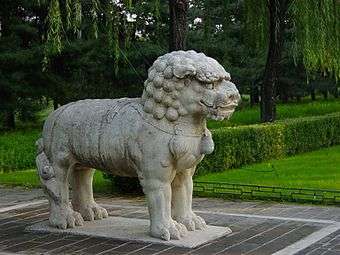Lion-Eating Poet in the Stone Den
"Lion-Eating Poet in the Stone Den" (Chinese: 施氏食獅史; pinyin: Shī-shì shí shī shǐ) is a short narrative poem written in Classical Chinese that is composed of 92 characters in which every word is pronounced shi ([ʂɻ̩]) when read in present-day Standard Mandarin, with only the tones differing.[1]

| Lion-Eating Poet in the Stone Den | |||||||||||||||||||||||
|---|---|---|---|---|---|---|---|---|---|---|---|---|---|---|---|---|---|---|---|---|---|---|---|
| Traditional Chinese | 施氏食獅史 | ||||||||||||||||||||||
| Simplified Chinese | 施氏食狮史 | ||||||||||||||||||||||
| Literal meaning | "The Story of Mr. Shi Eating Lions" | ||||||||||||||||||||||
| |||||||||||||||||||||||
The poem was written in the 1930s by the Chinese linguist Yuen Ren Chao as a linguistic demonstration. The poem is coherent and grammatical in Classical Chinese, but due to the number of Chinese homophones, it becomes difficult to understand in oral speech. In Mandarin, the poem is incomprehensible when read aloud, since only four syllables cover the entire 92 words of the poem. The poem is more comprehensible—but still not very intelligible—when read in other varieties of Chinese such as Cantonese, in which it has 22 different syllables, or Hokkien Chinese, in which it has 15 different syllables.
The poem is an example of a one-syllable article, a form of constrained writing possible in tonal languages such as Mandarin Chinese, where tonal contours expand the range of meaning for a single syllable.
Explanation
Chinese is a tonal language in which subtle changes in pronunciation could change the meaning.[2] In Romanized script, the poem is an example of Chinese antanaclasis.[2] The poem shows the flexibility of the Chinese language in many ways, including wording, syntax, punctuation and sentence structures, which gives rise to various explanations.[3]
The poem can be interpreted as an objection to the Romanization of Chinese. The 20th-century author Yuen Ren Chao used this poem as an example to object to the use of vernacular Classical Chinese which is used less in conversational daily life--classical Chinese is more written than spoken.[4][5]
The poem is easy to understand when read in its written form in Chinese characters, due to each character being associated with a different core meaning. It is also intelligible in its spoken form in Sinitic languages besides Mandarin. However, when in its Romanized form or spoken Mandarin form, it becomes confusing.[4]
Evolution
The loss of older sound combinations in Chinese over the centuries has greatly increased the number of Chinese homophones. Many words in the passage had distinct sounds in Middle Chinese, but over time, all of the variants of spoken Chinese have merged and split different sounds. For example, when the same passage is read in Cantonese (even modern Cantonese) there are seven distinct syllables—ci, sai, sap, sat, sek, si, sik—in six distinct tone contours, producing 22 distinct character pronunciations. In Southern Min, there are six distinct syllables—se, si, su, sek, sip, sit—in seven distinct tone contours, producing fifteen character pronunciations. Therefore, the passage is barely comprehensible when read aloud in modern Mandarin without context, but easier to understand when read in other Sinitic languages, such as Cantonese.
See also
Related puns
- Homophonic puns in Mandarin Chinese
- List of linguistic example sentences
- James while John had had had had had had had had had had had a better effect on the teacher
- Buffalo buffalo Buffalo buffalo buffalo buffalo Buffalo buffalo
- Neko no ko koneko, shishi no ko kojishi
References
- Behr, Wolfgang (2015). "Discussion 6: G. Sampson, "A Chinese Phonological Enigma": Four Comments". Journal of Chinese Linguistics. 43 (2): 719–732. ISSN 0091-3723. JSTOR 24774984.
- Forsyth, Mark. (2011). The Etymologicon : a Circular Stroll through the Hidden Connections of the English Language. Cambridge: Icon Books. pp. 62–63. ISBN 9781848313224. OCLC 782875800.
- Hengxing, He (2018-02-01). "The Discourse Flexibility of Zhao Yuanren [Yuen Ren Chao]'s Homophonic Text". Journal of Chinese Linguistics. 46 (1): 149–176. doi:10.1353/jcl.2018.0005. ISSN 2411-3484.
- 彭, 泽润 (2009). "赵元任的"狮子"不能乱"吃"——文言文可以看不能听的原理" [Zhao Yuanren's "lion" cannot be "eaten": the reasons why Classical Chinese can be read instead of being listened to]. 现代语文:下旬.语言研究 (12): 160.
- 张, 巨龄 (11 January 2015). "赵元任为什么写"施氏食狮史"" [Why Zhao Yuanren wrote Lion-Eating Poet in the Stone Den]. 光明日报. Retrieved 22 May 2019.
External links
- The Three "NOTs" of Hanyu Pinyin has a similar but different text
- 對聯:30. 巧聯妙對
- How to Read a Chinese Poem with Only One Sound has a transcription of the passage in Traditional and Simplified Chinese, as well as a Pinyin transcription and a translation.